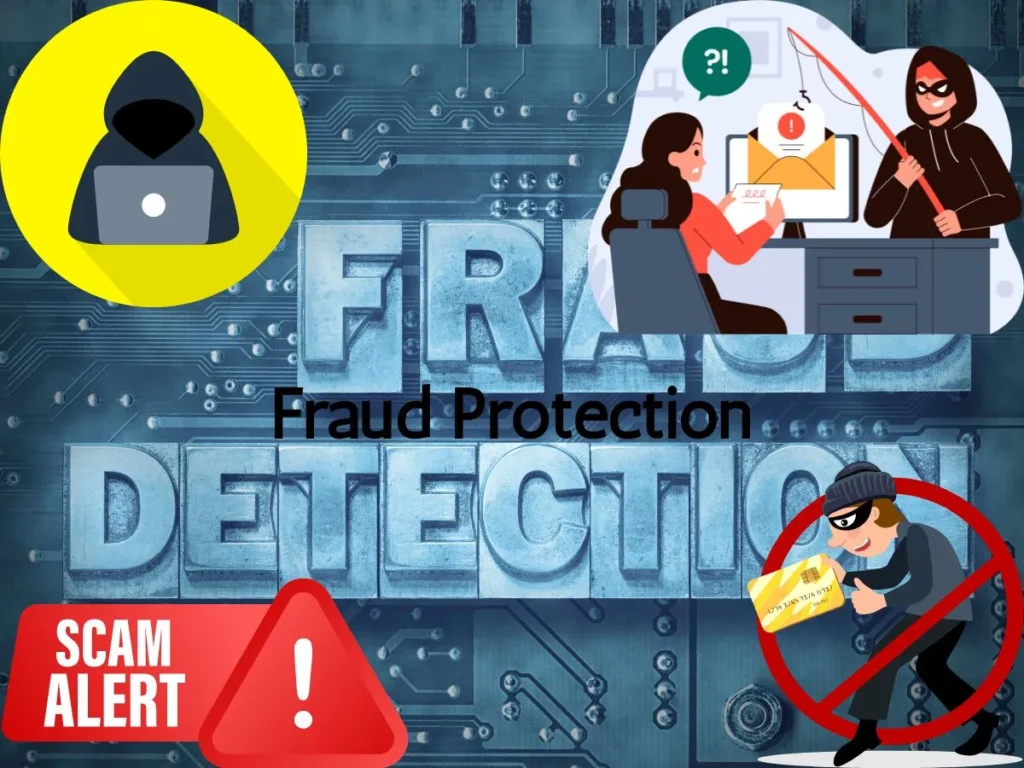Table of Contents
ToggleUnderstanding Cyber Fraud

In today’s digital age, Cyber fraud has become a significant threat to individuals and organizations alike. Cybercriminals employ various tactics to deceive and steal sensitive information, leading to substantial financial and data losses. It is crucial to understand the different forms of cyber fraud to effectively protect oneself.
The most common types include:
Phishing:
Fraudsters use deceptive emails or messages to trick individuals into providing personal information or clicking on malicious links.
Identity Theft:
Criminals steal personal information to impersonate someone, often leading to unauthorized financial transactions.
Malware Attacks:
Malicious software infiltrates systems to steal data or cause damage.
Ransomware:
Attackers encrypt data and demand a ransom for its release.
Credit Card Fraud:
Unauthorized use of credit card information for fraudulent transactions.
Precautions to Save from Cyber Fraud
Use Strong, Unique Passwords
A fundamental step in protecting against cyber fraud is using strong, unique passwords for all online accounts. A robust password typically includes:
A mix of uppercase and lowercase letters
Numbers
Special characters
Avoid using easily guessable information such as birthdays or common words. Consider using a **password manager** to generate and store complex passwords securely.
Enable Two-Factor Authentication (2FA)
Two-Factor Authentication (2FA) adds an extra layer of security by requiring two forms of identification before granting access to an account. This typically involves a combination of:
Something you know (password)
Something you have (smartphone, hardware token)
Something you are (biometrics)
2FA significantly reduces the risk of unauthorized access, even if a password is compromised.
Keep Software Updated
Regularly updating software is essential to protect against cyber fraud. Software updates often include patches for security vulnerabilities that cybercriminals exploit. Ensure that all operating systems, applications, and antivirus programs are up to date.
Use a Reliable Antivirus Program
A reliable antivirus program can detect and remove malware, spyware, and other malicious software. Choose a reputable antivirus solution that offers real-time protection and regular updates.
Secure Your Network
Securing your home or business network is crucial for preventing cyber fraud. Implement the following measures:
Use a strong, unique password for your Wi-Fi network.
Enable network encryption (WPA3 is recommended).
Disable remote management features.
Regularly update your router’s firmware.
Use a Virtual Private Network (VPN) for an added layer of security.

Educating Yourself and Your Team
Recognize Phishing Attempts
Phishing attacks are among the most common cyber fraud tactics. Educate yourself and your team to recognize phishing attempts by:
Checking the sender’s email address for inconsistencies.
Hovering over links to verify their legitimacy before clicking.
Being wary of urgent or threatening language.
Not providing personal information in response to unsolicited requests.
Regular Cybersecurity Training
Regular cybersecurity training is essential to keep up with the evolving tactics of cybercriminals. Training should cover:
Identifying different types of cyber threats.
Safe browsing habits.
Secure email practices.
Response protocols for suspected cyber fraud.
Stay Informed About the Latest Threats
The landscape of cyber fraud is continually changing. Stay informed about the latest threats and cybersecurity trends by following reputable sources such as:
Cybersecurity blogs and forums
News outlets focused on technology and security
Official advisories from government agencies
Protecting Personal and Financial Information
Monitor Financial Statements Regularly
Regularly monitoring your financial statements can help detect unauthorized transactions early. Review bank statements, credit card bills, and investment accounts for any discrepancies.
Set Up Account Alerts
Many financial institutions offer **account alerts** that notify you of suspicious activity. Set up alerts for:
Large transactions
Unusual login attempts
Changes to account information
Shred Sensitive Documents
Shred any documents containing personal or financial information before disposing of them. This includes:
Bank statements
Credit card offers
Medical bills
Insurance documents
Use Secure Payment Methods
When making online purchases, use secure payment methods such as:
Credit cards, which offer better fraud protection than debit cards
Digital wallets (e.g., PayPal, Apple Pay) that provide an additional layer of security
Responding to Cyber Fraud
Report the Fraud
If you become a victim of cyber fraud, it is crucial to report it immediately. Contact:
Your financial institution to freeze affected accounts.
Credit bureaus to place a fraud alert on your credit report.
Local law enforcement to file a report.
Change Compromised Passwords
Immediately change the passwords of any compromised accounts. Ensure that the new passwords are strong and unique.
Monitor for Further Fraudulent Activity
After reporting the fraud, continue to monitor your accounts for any additional unauthorized activity. Consider enrolling in an identity theft protection service that offers continuous monitoring and alerts.
Educate and Prevent Future Incidents
Learn from the incident to prevent future occurrences. Review what went wrong and strengthen your cybersecurity measures accordingly.
Advanced Cybersecurity Measures
In addition to basic safety practices, there are advanced measures that can further enhance your cybersecurity and protect you from sophisticated cyber fraud attempts.
Virtual Private Network (VPN)
A VPN encrypts your internet connection, making it difficult for cybercriminals to intercept your data. It is particularly useful when using public Wi-Fi networks, which are often less secure.
Secure Browsing Extensions
Utilize browser extensions that enhance security, such as ad blockers, anti-phishing tools, and script blockers. These can help prevent malicious scripts from running and block potentially harmful websites.
Regular Software Updates
Ensure all your software, including your operating system, browsers, and any applications, are updated regularly. Updates often include patches for security vulnerabilities that cybercriminals might exploit.
Data Encryption
Encrypt sensitive data on your devices. This ensures that even if a cybercriminal gains access to your files, they cannot read the encrypted information without the decryption key.
Behavioral Analytics
Implement behavioral analytics solutions that monitor user behavior patterns. Unusual activities, such as access attempts from unfamiliar locations, can trigger alerts and prevent potential breaches.
Cybersecurity Best Practices for Businesses
Businesses are prime targets for cyber fraud due to the vast amount of data they hold. Here are some best practices specifically for businesses to safeguard against cyber threats:
Employee Training Programs
Conduct regular training sessions to educate employees about the latest cybersecurity threats and best practices. This can include recognizing phishing emails, safe internet browsing, and secure password management.
Access Controls
Implement strict access controls to ensure that only authorized personnel have access to sensitive information. Use role-based access control (RBAC) to limit data access based on the user’s role within the organization.
Incident Response Plan
Develop and maintain a comprehensive incident response plan. This plan should outline the steps to be taken in the event of a cyber attack, including communication protocols, roles, and responsibilities, and recovery procedures.
Regular Security Audits
Conduct regular security audits to identify vulnerabilities within your systems. This can involve penetration testing, vulnerability assessments, and compliance checks to ensure that your cybersecurity measures are effective and up-to-date.
Data Loss Prevention (DLP) Solutions
Implement DLP solutions to monitor and protect sensitive data. DLP tools can prevent unauthorized access and sharing of critical information, helping to safeguard your business from data breaches.
Emerging Threats and Future Trends in Cybersecurity
The landscape of cyber threats is constantly evolving. Staying informed about emerging threats and future trends is crucial for maintaining robust cybersecurity.
Artificial Intelligence (AI) in Cybercrime
Cybercriminals are increasingly using AI to launch more sophisticated attacks. AI can automate phishing attacks, develop more effective malware, and even mimic human behavior to evade detection.
Internet of Things (IoT) Vulnerabilities
With the proliferation of IoT devices, new vulnerabilities are emerging. Many IoT devices have weak security features, making them easy targets for cybercriminals. Ensuring that these devices are secure is essential for overall cybersecurity.
Quantum Computing
While still in its early stages, quantum computing poses both opportunities and threats to cybersecurity. On one hand, it can enhance encryption methods; on the other hand, it has the potential to break current encryption algorithms, necessitating the development of quantum-resistant encryption.
Regulatory Changes
Governments worldwide are implementing stricter cybersecurity regulations. Staying compliant with these regulations is crucial for businesses to avoid penalties and protect customer data.
Final Words on Cyber Fraud
Protecting yourself from cyber fraud requires a combination of basic practices and advanced measures. By staying informed about the latest threats and continuously updating your cybersecurity strategies, you can significantly reduce the risk of becoming a victim of cyber fraud. Businesses, in particular, need to invest in comprehensive cybersecurity measures and foster a culture of security awareness among employees. By understanding the different types of cyber fraud, implementing robust cybersecurity measures, educating yourself and your team, safeguarding personal and financial information, and responding swiftly to incidents, you can significantly reduce the risk of falling victim to cybercriminals.
